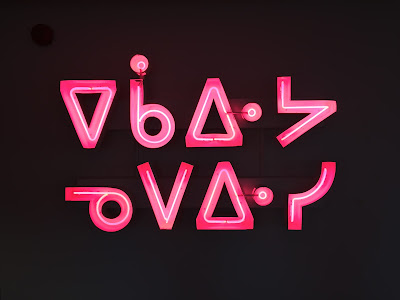BY: SADIE MACDONALD
This week, I decided to take a break from studying and visit the exhibits up for offer at the Art Museum at the University of Toronto. At the moment, there are two major exhibitions: Figures of Sleep and Morning Star. One exhibition, dimly lit and shadowed in quiet darkness, investigates concepts of sleep; the other, located on a brightly-lit upper floor, focuses on illuminating Indigenous artists.
Figures of Sleep is on display at the University of Toronto Art Centre location. Curated by Sarah Robayo Sheridan, this exhibition “considers the cultural anxieties manifest in the popular and critical imagination around the collapsing biological function of sleep under economic, social and technological transformation.” I must say, as a graduate student with an utterly wrecked sleep schedule, the topic of sleep has been a personal concern for me for a while, so I was interested in visiting this show.
When you first walk into the Art Museum, you'll notice that the the gallery has black walls and very little lighting, creating a unique exhibition experience as you explore the space in darkness. This is an interesting and highly appropriate design choice for an exhibit that's all about sleep. This strategy does have its drawbacks, however, as some of the labels are faintly lit. In any case, even if you are able to read them, they will not tell you much about the context of the works on display.
Some of the images may not need context, and will be bolstered by the visitor’s own interpretations. Louise Bourgeois’s Insomnia Drawings certainly evoked for me the feelings of an overactive, tired mind struggling to fall asleep. For other works, I was keen to learn more about what I was seeing. On Kawara’s I Got Up series consists of a collection of postcards, written and sent between 1968 to 1979; in this series, Kawara recorded the times he woke up each day as he travelled around the world. I recognized that the postcards on display in this exhibition were collected in Halifax (one even featuring my alma mater!). I wish that more in-gallery context had been provided regarding the artist’s journey and goals, which certainly intrigued me as I examined the postcards.
Lack of context aside, the exhibition will make you think as it offers explorations of other themes branching off from the basic topic of sleep. Rebecca Belmore’s Dream Catcher caught me in my tracks. This textile image depicts an Indigenous person sleeping on a concrete sidewalk, and has several details speaking to the urgency of current Indigenous activist movements such as Idle No More.
Figures of Sleep features many works that confront ideas related to sleep, from many different times and places. This exhibition may be all about sleep, but it certainly will not put one to sleep.
 |
| Untitled (old woman in bed) by Ron Mueck almost gave me a heart attack. Photo courtesy of Sadie MacDonald |
If you want to visit Morning Star, you will have to make a journey to the Jackman Humanities Institute. The exhibition is so called because it “ascends to shine light on presence, visibility and collective Indigenous agency to renounce naïve impressions of (re)conciliation that continue to be discussed throughout much of the settler culture across Turtle Island.” Curated by Jason Baerg and Darryn Doull, Morning Star features the works of established Indigenous artists such as Alex Janvier and Garry Todd as well as contemporary artists like Adrian Stimson. My colleague, Amy Intrator, will write about this exhibition in depth later this week, but I will briefly introduce it here.
 |
| ᐁᑳᐃᔹ ᓀᐯᐃᓸ (ēkāwiya nēpēwisi) by Joi T. Arcand. Photo courtesy of Sadie MacDonald. |
Joi T. Arcand’s neon channel signs capture one’s eye immediately. They are not translated for non-Indigenous comfort of viewing. As such, the illuminated text perfectly encapsulates the exhibition’s themes of “shining a light” on Indigenous agency. The photography of Nadya Kwandibens, which features Indigenous people fearlessly walking the streets of Toronto, likewise challenges settler perceptions.
One captivating work on display is Bracken Hanuse Corlett’s animated film Ghost Food. There is no dialogue, just a soundtrack of haunting music, but the story of two characters attempting to hunt for food in an urban wasteland offers an intriguing visual journey nonetheless. You can view the video below.
Morning Star was created in partnership with the Jackman Humanities Institute, but the 170 St. George Street location may not have been the most visible space for displaying this exhibit. Housed on the tenth floor of the building, it is only open from 9am to 4 pm from Monday to Friday. Fortunately, Morning Star has a long run, ending later this summer, which does provide more opportunities for seeing it. The Jackman Humanities Institute is also not a typical gallery space; you might have to squeeze past chairs and tables to get a closer glimpse at some of the work on display, which gave me reason to worry about its accessibility. Once you are able to engage with the works on display, the results are worth it.
Though both exhibits have logistical flaws, the works that compose the exhibit are powerful and captivating. Figures of Sleep’s run will end on March 3rd, so I suggest that you see it sooner rather than later. Drop-in tours are offered every Friday at 2pm. Morning Star will run until August 14, 2018.




No comments:
Post a Comment
Note: only a member of this blog may post a comment.